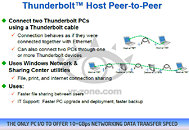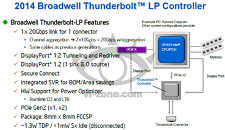Friday, November 29th 2013

Intel's 2014 Thunderbolt Controller Detailed
Intel is continuing on its mission to establish Thunderbolt as the next universal device interconnect standard, despite steep competition from the 5 Gb/s USB 3.0, the upcoming 10 Gb/s USB 3.1, and stringent validation and licensing barriers on its own end. To that effect, the company outlined its mainstream Thunderbolt controller, which it plans to launch some time in 2014. The company is planning two major introductions to the standard, to help it compete against USB - power delivery, and ad-hoc (peer-to-peer) networking.
The controller, Broadwell Thunderbolt-LP, isn't designed too differently from what's available in the market. It handles a 20 Gb/s Thunderbolt link by aggregating two 10 Gb/s channels, relays DisplayPort 1.2 from the system's graphics device, and connects to the rest of the system over PCIe 2.0 x2. The chip is built in the 8 x 8 mm package, and features operational and idle TDP ratings of 1.5W and 1mW, respectively. The changes Intel is making to the standard will enable power delivery of up to 53W over a standard tethered cable. That's enough power to run a drive dock with up to six 3.5-inch hard drives, or a small (<24-inch) flat-screen monitor. The other big feature is ad-hoc networking, which enables people to set up peer-to-peer 20 Gb/s connections between two PCs much in the same way they did with USB and RS232, back in the day. While it's no Ethernet replacement, it could prove useful in certain environments, such as content-creation. Intel is expected to make some Thunderbolt-related announcements at CES, next January.
Source:
VR-Zone
The controller, Broadwell Thunderbolt-LP, isn't designed too differently from what's available in the market. It handles a 20 Gb/s Thunderbolt link by aggregating two 10 Gb/s channels, relays DisplayPort 1.2 from the system's graphics device, and connects to the rest of the system over PCIe 2.0 x2. The chip is built in the 8 x 8 mm package, and features operational and idle TDP ratings of 1.5W and 1mW, respectively. The changes Intel is making to the standard will enable power delivery of up to 53W over a standard tethered cable. That's enough power to run a drive dock with up to six 3.5-inch hard drives, or a small (<24-inch) flat-screen monitor. The other big feature is ad-hoc networking, which enables people to set up peer-to-peer 20 Gb/s connections between two PCs much in the same way they did with USB and RS232, back in the day. While it's no Ethernet replacement, it could prove useful in certain environments, such as content-creation. Intel is expected to make some Thunderbolt-related announcements at CES, next January.


17 Comments on Intel's 2014 Thunderbolt Controller Detailed
Intel has successfully made the next generation of Firewire.
1) Make a new standard that eschews what the rest of the industry is doing.
2) Have Apple introduce it, be exclusive with it for a good long time, and let them be the ones to name it.
3) Keep it outrageously expensive for even longer.
4) Let the cheaper, more common competition continuously update their standard to the point where yours has only the tiniest of advantages before you finally drop your prices.
5) Keep at room temperature. Enjoy!
Intel would need to allow DisplayPort from any source (drop the Intel iGPU nonsense) or possibly make DisplayPort optional before it could really take off as well as lower the cost of implementation.
USB 3.0 (and likely USB 3.1) is easy, cheap and nonrestrictive to take advantage of but Thunderbolt is anything but that. Intel needs to fix this or most people simply won't give a $#!t.
Hands up anyone who even has even owned a FireWire device?
I still would love to see Thunderbolt expanded. Would make perfect universal laptop docking stations.
Actually Thunderbolt has an issue with contradiction as well. One might think Thounderbolt is intended for higher-end motherboards because of a price premium. However, higher-end motherboards such as X79 boards are not eligible for Thunderbolt support due to the lack of an Intel iGPU which only leaves typically less expensive and not as high-end Z77 / Z87 boards.
It's something of a Goldie Locks symdron, it can't be too hot and it can't be too cold it has to be just right. You don't get Thunderbolt on truly high-end boards like X79 and you don't get Thunderbolt on cheap lower-end boards (or AMD based boards) you only get it with the middle or upper-middle-end boards Z77 / Z87.
I'll be looking at Haswell-E / X99 / LGA2011-3 motherboards whenever they are released (late 2014 ?) and I don't necessarily expect Thunderbolt or an Intel iGPU on the platform (I've heard no info on either in this respect). At this point I am not even sure I care about Thunderbolt but I definitely won't let it influence my buying decisions on such boards.
As I said before, Intel is impeding adoption of Thunderbolt by keeping it exclusive (too many requirements and restrictions) and keeping the user base small which forces the price to remain high.
From Intel's perspective, the Thunderbolt target market doesn't need anything but Intel graphics. Naturally that leaves us all out in the cold. With any luck USB 3.1 can address this somewhat but I doubt it. I agree that functionality and performance is left on the table by Intel's insistence in pushing their iGPU at the detriment of non-Intel graphics,....
It would be laughable if Intel weren't so dead serious about it but since they are it just comes off as sad and deluded.
Well it had a FireWire 800 port, but it also had E-SATA. Which actually worked, and worked well enough I NEVER used the FireWire port.
I see two issues here though, they are robbing peter to pay paul in PCIe lanes for people that will actually use it, and the standards read like a bad divorce so expecting easy or complete compliance for anything but high end components is going to be a joke.
my 46" LED HDTV only uses 45W (measured at the wall) with the backlight at 2 out of 5.
you can run a pretty big screen off this if they lowered the maximum settings.
So yeah, this is still boring news...for now.